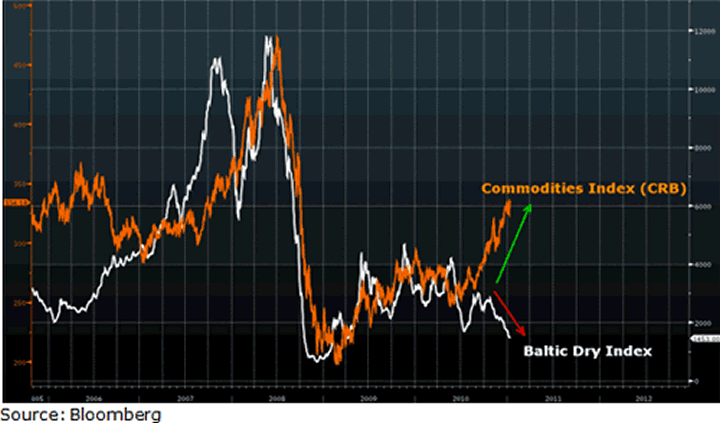Be Wary of Rosy Economic Outlooks for 2011 … and Profit Along the Way!
Economics / Global Economy Jan 15, 2011 - 07:53 AM GMTBy: Bryan_Rich
 Last year Byron Wien, the former Morgan Stanley strategist, former billion-dollar hedge fund strategist, current Vice-Chairman of Blackstone and highly touted market prognosticator predicted 2010 would be a V-shaped recovery for the U.S. economy.
Last year Byron Wien, the former Morgan Stanley strategist, former billion-dollar hedge fund strategist, current Vice-Chairman of Blackstone and highly touted market prognosticator predicted 2010 would be a V-shaped recovery for the U.S. economy.
He was wrong …
He expected 5 percent GDP growth for 2010. Instead we got a Fed-induced 2.5 percent.
He also predicted the 10-year yield would rise to 5.5 percent. It rose to 4 percent then fell to 2.3 percent, before rising back to the mid 3s.
He foresaw the Fed going on a major rate hiking campaign. Instead, the Fed not only held the line on its near-zero interest rates but proceeded to roll out even easier monetary policy through another big round of quantitative easing.
With more predictions about a robust Japan and a fairly stable U.S. political climate, Wien’s record for 2010 was an unimpressive 1 for 10 — he was right on a euro decline back below 1.30.
Now, for 2011, Wien offers a similar bullish growth and interest rate outlook for the U.S. economy. What’s more, he has equally bullish projections for U.S. stocks, employment, housing, global commodities and global stability in general.
Here’s a look at a few more of his key predictions:
- The crisis in Europe will be quelled again by “psychologically satisfying” policies,
- China will find it in their best interest to let the yuan appreciate, and …
- The S&P 500 will rise almost to its all-time high, gold will reach $1,600 and the dollar will be driven higher against the euro and yen from stronger growth and interest rate prospects.
But Is All This Optimism Warranted? Not According to History …
It’s no surprise that market professionals, economists, and politicians tend to view the environment in a rosier tone. After all, it’s much more comforting to believe that a sustained recovery for global economies is right around the corner.
But history shows it’s not likely …
The most extensive study on historical debt crises suggests that the decade-long build-up in credit will take at least a similar amount of time to unwind.
And this “deleveraging period” will likely have the following characteristics:
- Economic growth will remain at lower levels than pre-crisis growth
- Unemployment will hover around five percentage points higher than pre-crisis levels
- And housing prices will remain anywhere from 20 percent to 50 percent below peak levels.
This should give you clear perspective on where we stand in the current downturn: If December 2007 marked the beginning of the U.S. recession, we’re just a third of the way through this deleveraging cycle!
That’s why it’s more likely that 2011 will not pan out the way optimists like Wien predict.
Despite the recent run-up in global yields, and despite the hoarding of commodities in China, neither reflects the trajectory of global prices based on real consumer demand.
In fact, the data shows that consumer demand remains very depressed.
Take a look at the following chart of the Baltic Dry Index, represented by the white line. This index gauges the price of moving major raw materials by sea — a good proxy for global demand …

As you can see, when the credit bubble was expanding to its most extreme level from 2005 to 2007, this index surged dramatically.
You can also see in this period how commodities (the orange line) responded with a strong surge, to correspond with the strong global demand.
Now, take a look at the dramatic collapse of both of these indices in 2008 when the credit bubble burst, the music stopped, and the world entered major economic crisis mode.
The Baltic Dry index fell 94 percent and the index that tracks a broad basket of commodities fell 58 percent!
And now, despite all of the optimism about recovery … despite the perception that government intervention can goose demand … and despite the fact that countries like China have been speculating on commodities like crazy … the Baltic Dry Index is showing us that demand from other areas is practically non-existent.
That’s why I continue to think the optimists here in the U.S. will end up disappointed yet again in 2011 … and that uninformed investors are facing much higher risks than they realize.
With that said, there will be plenty of opportunities to profit along the way.
I expect global capital to continue shifting toward relative safety. And in a world with few options, the dollar and gold will be among the best alternatives.
Regards,
Bryan
This investment news is brought to you by Money and Markets. Money and Markets is a free daily investment newsletter from Martin D. Weiss and Weiss Research analysts offering the latest investing news and financial insights for the stock market, including tips and advice on investing in gold, energy and oil. Dr. Weiss is a leader in the fields of investing, interest rates, financial safety and economic forecasting. To view archives or subscribe, visit http://www.moneyandmarkets.com.
© 2005-2022 http://www.MarketOracle.co.uk - The Market Oracle is a FREE Daily Financial Markets Analysis & Forecasting online publication.



